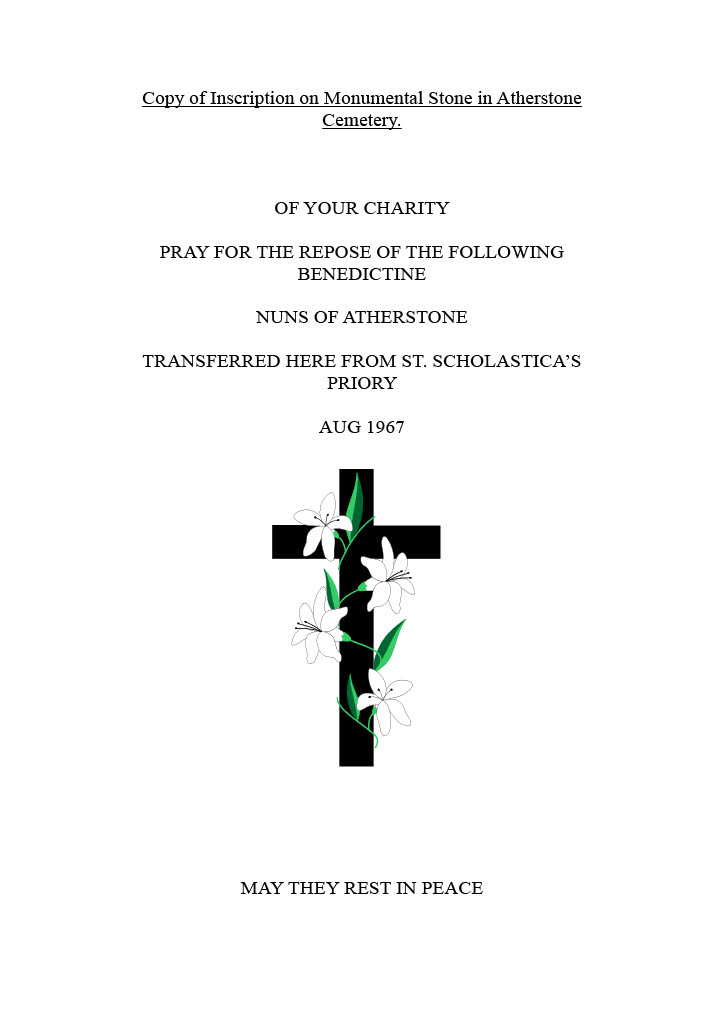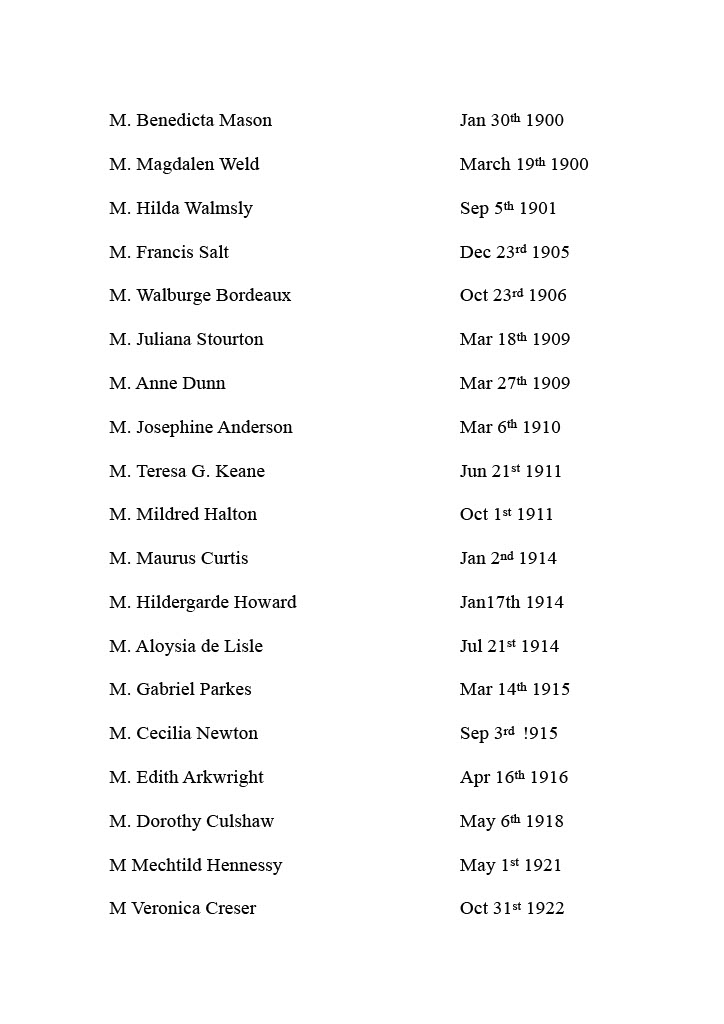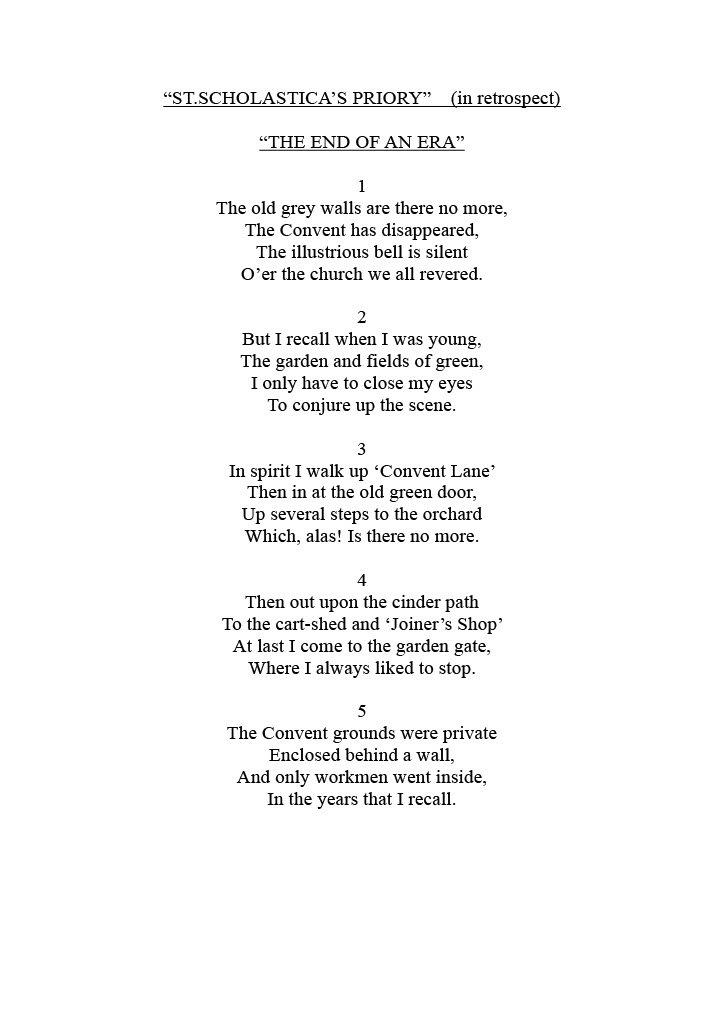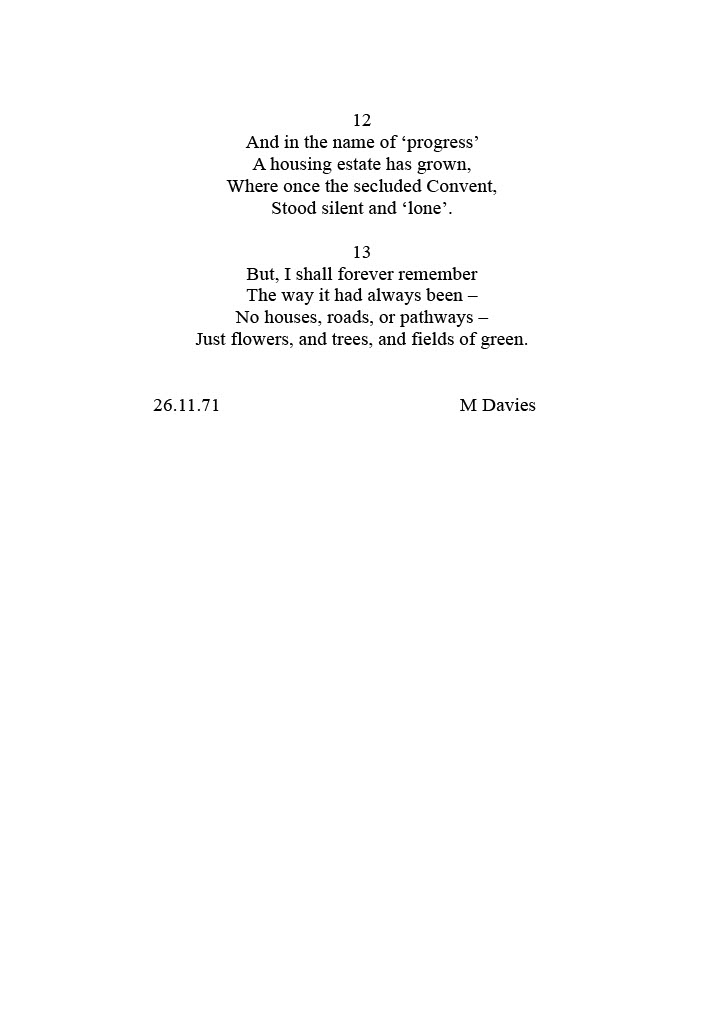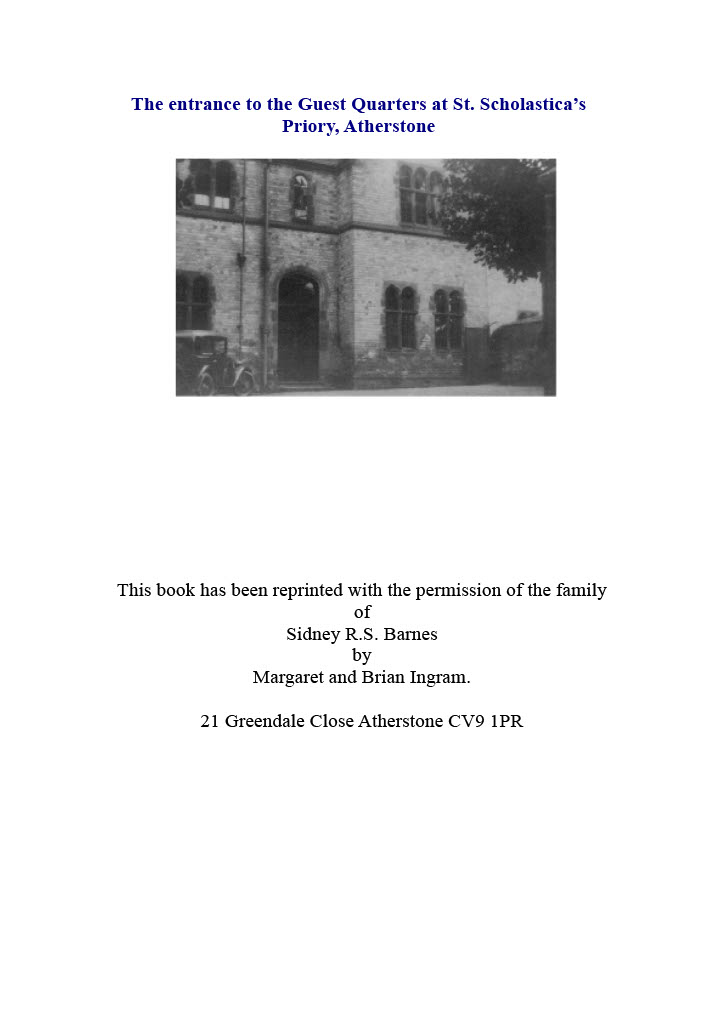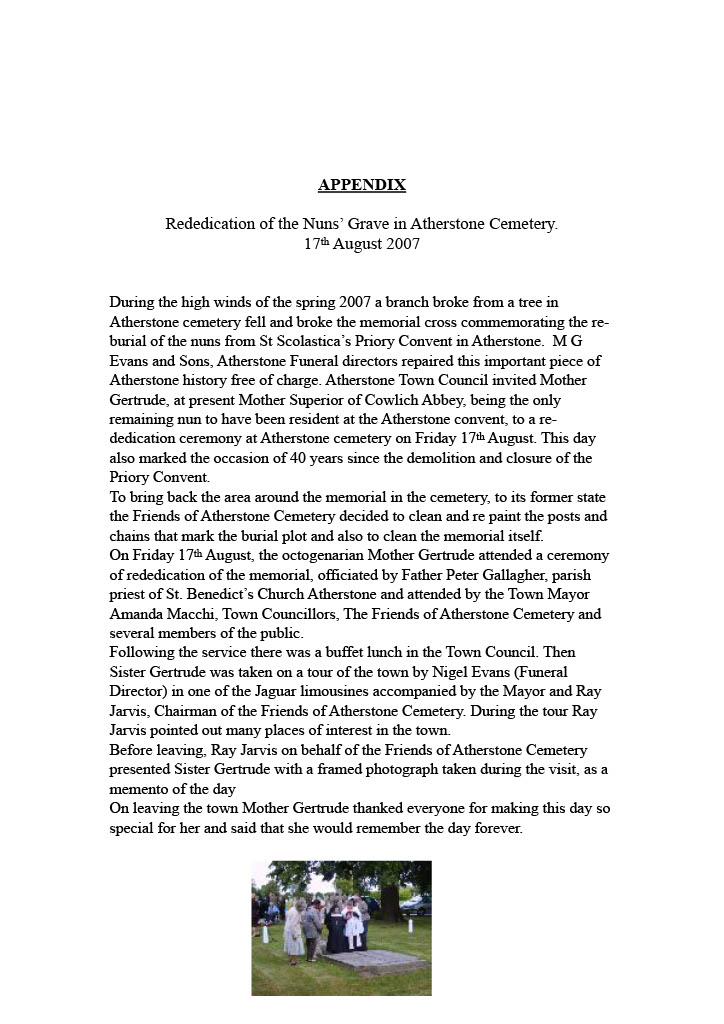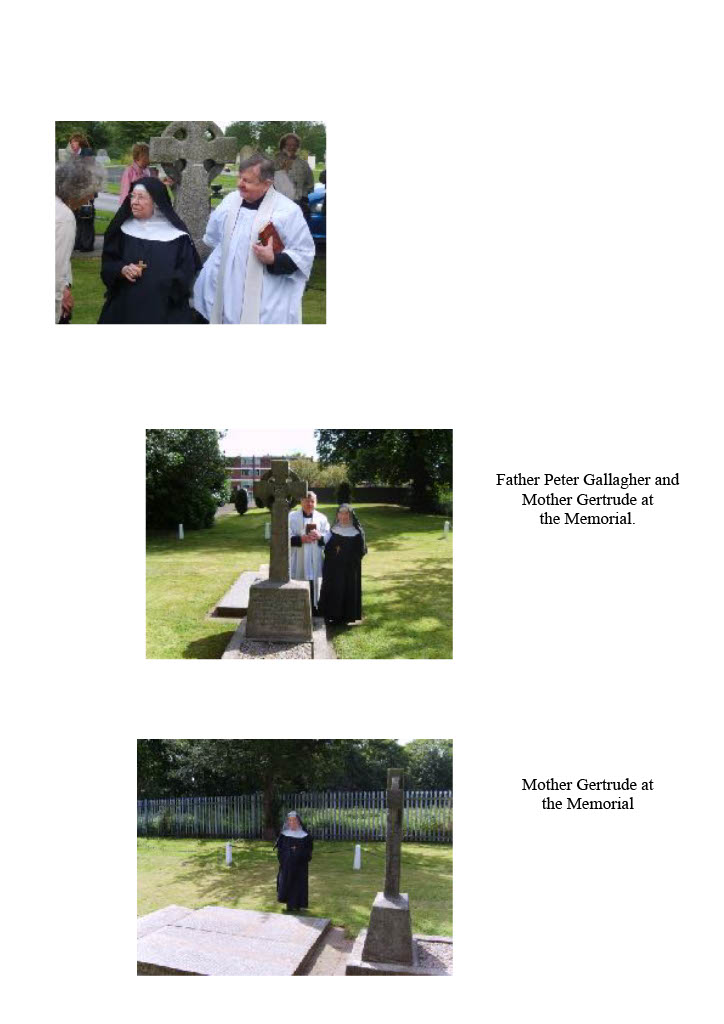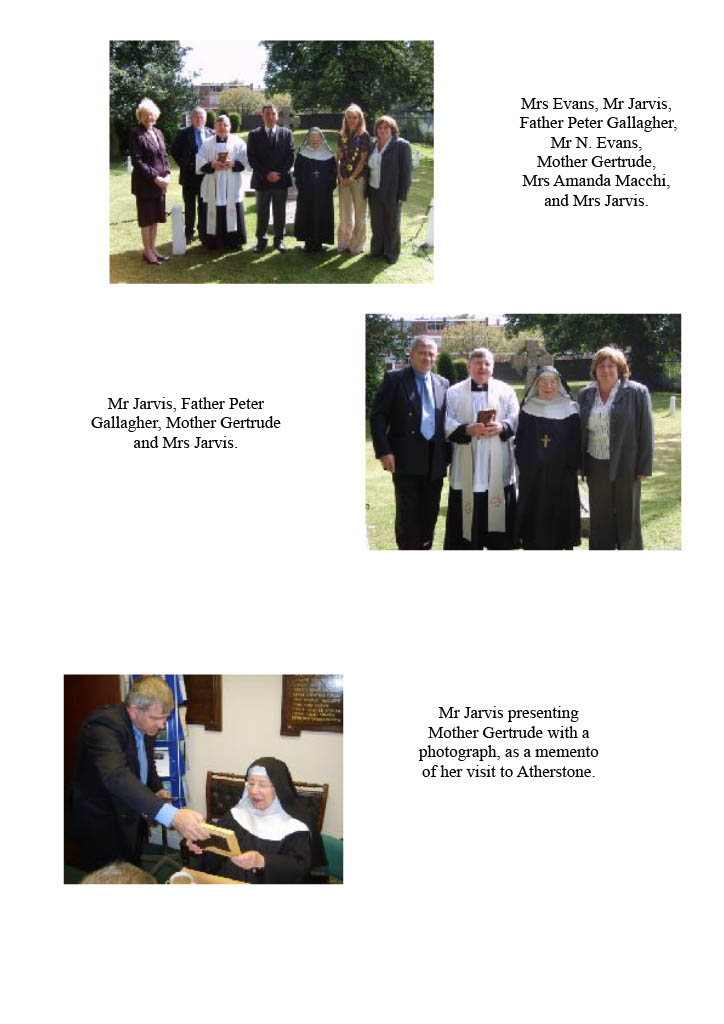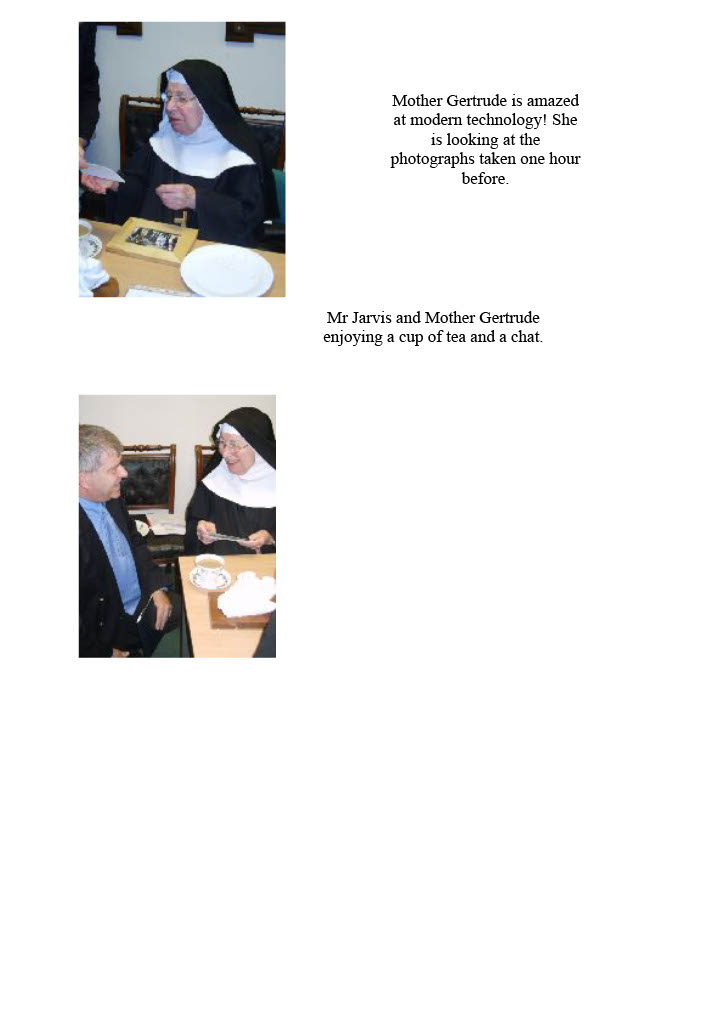OUR HISTORY – ATHERSTONE CONVENT PRIORY
1837 – 1967
BY SIDNEY. R. S. BARNES
‘CHANGING SCENES’
1968/1989





Grateful thanks are due to the Reverend Mother Prioress Flavia Bunce O.S.B.and the Reverend Sister M. Clare O.S.B. of St. Scholastica’s Priory, Atherstone, to the Reverend Mother Prioress Mary Imelda Ashworth O.P. and the Reverend Sister Mary Albert O.P. of St Dominic’s Priory, Carisbrooke, Isle of Wight, for their very willing help and co-operation in supplying information concerning their respective communities stay at Atherstone Priory Convent.

Thanks must also go to Mr. D. G. Lewis, the new owner of the Priory Site for kindly allowing information to be quoted from the Title Deeds regarding the Priory Convent, and his generosity in presenting to the Atherstone Public Library some very old documents and abstracts of documents going back to 1756.
Also, many thanks to the Reverend Father Peter Gallagher of St. Benedict’s Roman Catholic Church, and the Reverend Vicar Paul Harris of St. Mary’s Church, Atherstone, for allowing photographs to be taken of the reconstructed parts of the Saint Scholastica’s Chapel Altar, that have been erected in their respective Churches.
The author also wishes to thank, Mr. Ted Norman, Church Warden at Atherstone. St. Mary’s Church for his very willing help in providing many answers concerning queries relating to Atherstone’s Church of St. Mary.
A large number of the founders of the Orders that came into being centuries ago, had the inspiration and help of a wise woman or a sister’s loyal friendship in those early days. Throughout the ages women have walked along side since the day when God made Adam ‘a help like unto himself’ because it was ‘not good for him to be alone’. They have given direct or indirect co-operation to their male partners, for the betterment of many causes.
It was said that during the earliest Christian times, veiled virgins formed a grade or order apart from the ordinary community, and that there were organised convents for women long before there were Monasteries for men? It is also thought that when St. Anthony left the world in 270 to embrace the ascetic life, he placed his sister in a nunnery.
We learn from Palladius? that by the end of the 4th century there were numerous nunneries all over Egypt, and that they also existed in Palestine, Italy and in Africa – in fact throughout the Christian World. As the various monastic and mendicant orders evolved, a female branch was usually formed alongside of the Order.
And so it continues throughout the centuries, with the introduction of many new religious Orders under Dominican, Benedictine, and other rules with the nuns facing great adversities and perils in the glorious privilege of spending their lives in the direct service of God.
Benedictine Nuns that had lasted for 130 years. During this period the Priory During the month of July 1967, St. Scholastica’s Convent, Atherstone, closed down. It was the end of an era of worship and praise to God by Dominican and had been inhabited by nuns belonging to two different Orders, who despite periods of poverty and many difficulties arising from the effects of two World Wars, had kept a life of prayer and praise of God for which their life was intended.
We can only briefly mention the many acts of kindness and charity that these Nuns performed during their stay at Atherstone. They were all performed in their direct service of God, which was to win souls for the Kingdom of Heaven, by being ‘Love’ in the heart of the Church, embracing the Hidden Life of prayer at the foot of the Tabernacle.
As the story to be told deals with Nuns belonging to the Order of Dominicans and the Order of Benedictines, who, each in turn, occupied the Atherstone Priory Convent, their stories will be dealt with separately. Brief outlines of the Inauguration of the Nuns to the Monastic Order, and how they came to that life of prayer and praise of God, with the rise of each community, followed by the history of its stay in Atherstone, and subsequent move to last known settlements, will be presented.
The Order of Dominicans
It was St. Dominic who founded the Order of Dominicans, otherwise called Friars Preachers, and in England, Black Friars, which Pope Innocent III confirmed by two bulls December, 1216. Ten years before, from 1205-1215, Dominic had been charged to preach among the Albegensian heretics in Languedoc. During this mission he was responsible for the conversion of the daughters of these Albegensian nobles in his first convent of nuns nearly ten years before he founded that of the friars. The Sisters Preacheresses, (which is what the nuns were called), were told that the aim of their life in the cloister was “the salvation of souls”.
The Friars Preachers came to England and were established at Oxford in 1221, with the only nunnery being at Dartford, 1356-1539. After this convent had been suppressed by Henry VIII, they went to Belgium, and later to Bruges.
The English Community
In 1661 the present English community was founded by Philip Thomas Howard, O.P., Cardinal of Norfolk, at Vilvorde, a small town in South Brabant, on the River Senne, between Brussels and Mechelin. Two Dutch choir nuns and a lay Sister were sent from the Dominican convent of Temshe to begin the new community.
In 1669, they were moved to Brussels, where they stayed until June 25th 1794, when the Sisters were driven to England by the French Revolutionary Wars.
Six weeks after the nuns reached England, through the kindness of the Misses Berkeley (afterwards Mrs Canning and Lady Southwell) of Hindlip, Worcestershire, part of their father’s house was given up to their community. This was Hartpury Court, an old manor house near Gloucester. Here poverty forced the nuns to open a school. The school offered a modest education to “young ladies of from six to twelve years of age” who were required to wear black dresses and cap until 1813, after which they began to wear a veil and kerchief over their dress. In 1832 they were able to close the school and later in 1837, went to Atherstone.
The Convent of the Rosary – Atherstone 1837 – 1859
It was members of the Order of Dominicans who first came to Atherstone and erected The Convent of the Rosary, as the convent was then called, and whose Dominican name is in a special way associated with the foundation and propagation of the rosary.
On the 23rd September, 1837, the convent site was conveyed by the Trustees of the marriage settlement of Charles Holte Bracebridge of Atherstone Hall, to Ann Gregory, Francis Maria Russell, Jane Malthouse and Helen Malthouse and members of the community of nuns from Hartpury Court. The price paid for the site was £735. No buildings were referred to in the conveyance which was simply for a piece of land 3 acres 2 roods and 27 perches.
The nuns decided to build a Convent and new church at the cost of about £8,000, and an architect named Joseph Hanson drew up the plans. The foundation stone was laid October 18th 1837, by Ambrose Lisle Phillips of Grace Dieu Manor, and the Dominican Provincial, Friar Augustine Proctor was the officiating priest. The convent and the new church took about 2 years to build and on the 16th September1839, the first sisters arrived, with the rest following on the 19th September. The first Mass was said in the church on Sunday, September 22nd and it was blessed on the 30th September closely followed by the blessing of the Convent on November 16th.


The Church was officially opened December 6th 1849, by Bishop Walsh, Dr., afterwards Cardinal Wiseman, preached. The ‘big bell’ which took a prize at the first Great Exhibition at the Crystal Palace was given to the Dominicans by a gentleman who paid £100 for it.
It weighed 5cwt. and was cast to the note of ‘G’. The name Dominic Maria was engraved on it and it was known as the ‘Ave Maria Bell’ It was blessed by Bishop Ullathorne January 30th 1852, and rung for the first time February 11th.

In the building of the convent at Atherstone, it appears that the inexperience of the Prioress and her council led to infringement of the contract, which entailed considerable additional expense. After nineteen years of great poverty, the community were obliged to sell the Priory, and to find refuge once more in a secular house.
During this period Sister Helen Malthouse and Sister Gregory (two of the nuns mentioned in the Conveyance dated 23rd September 1837) died and were buried in the grounds of the Priory Convent, Atherstone.
Hurst Green 1856 –1866
The community found refuge at Hurst Green, near Stonyhurst, in Lancashire, through the generosity of a Mr. Parker, father of one of the nuns. He generously having made over to them his whole property, only reserving the use of his income while he lived, and a part of the house for his own dwelling. While at Hurst Green the nuns did some needle work for the Sacred Heart altar in the Jesuit church at Stonyhurst, and in return Father Clifford S.J. promised them, as a spiritual alms, that he would plead with the Sacred Heart to give them a convent where they could observe their Rule in its entirety. The prayers were answered. Elizabeth, Dowager Countess of Clare, who had been for some time a friend and benefactress to the community, offered to build them a convent in the Isle of Wight, and the offer was joyfully accepted.
St Dominic’s Priory – Isle of Wight 1866
On December 10th 1866, the nuns left Hurst Green for St Dominic’s Priory, Carisbrooke, travelling by night and landing next day in the Isle of Wight. It seems that whilst the convent was being erected, the caretaker at Carisbrooke cemetery, a Protestant, declared that he and another man had seen meteor- like stars falling down upon it, and had been puzzled by so strange a sight. Apparently it was taken as a mystic sign symbolic of great graces to be poured out upon the home of future sanctity.

The Carisbrooke community usually numbered about thirty, and the time of the sisters was divided between liturgical and mental prayer and work, both manual and intellectual, with two recreations a day. Sister Francis Maria Russell and Sister Jane Malthouse, died here at Carisbrooke, and so the last of the four Nuns to whom the Conveyance was made at Atherstone in 1837, had passed away.

The Sisters acquired some property at Old Headington, Oxford, where they hoped to make a new foundation as soon as practicable. The new community was to pray especially for the souls of those fallen in the late wars. This home was closed in 1967.
It appears that St. Dominic’s Priory, Carisbrooke, Isle of Wight, continues to thrive and carry out their dedicated work to God and mankind. Quite recently, on 11th December, 1967, they reached their 101st anniversary of their arrival at Carisbrooke. Surely a happy augury for the future.

Since writing about the Dominican Nuns stay at the Atherstone Priory Convent, and elsewhere, the author has had the very great pleasure of visiting St. Dominic’s Priory at Carisbrooke, and wishes to record ‘very sincere thanks’ for the hospitality shown to him and his wife, on this occasion.
St. Dominic’s Priory – Isle of Wight
During the month of October, 1989, it was reported in a national newspaper that St. Dominic’s Priory, Carisbrooke, would be closing down at the end of the month.
The sisters would be leaving St. Dominic’s Priory for a new home in a larger community in Hertfordshire after a stay of 123 years. Apparently the failure to attract younger women into the contemplative life and the strain of trying to keep going after the damage to the Priory in the 1987 hurricane had worn down resources and made life difficult.
They will be leaving the purpose built Priory for 30 nuns, that the Dowager Countess of Clare had provided for them in 1866. Only 5 nuns remained in the Priory, including Sister Mary Catherine Kelly, aged 95 years, who had been at the Priory since the end of the first world war. The present Prioress Sister Mary John, in 1966 became the last permanent recruit to join 22 other sisters, of these 3 nuns have died since the storm.
When the nuns arrived in Carisbrooke they were booed and jeered. They were the first religious community on the staunchly Protestant island since the Reformation. Sister Mary John believes their departure will elicit an altogether different response from the islanders. They keep saying “you’ve always been there”. “Every time I pass the Priory I hear your bell, and I think you are there.” The reaction is one of great sadness.
“We are going to go out on a wave of regret and love, which is very consoling.”
The last community Mass was celebrated in the Chapel at 9 am on Tuesday the 17th of October 1989.

The Order of Benedictines
Before writing about the Nuns belonging to St. Scholastica’s Priory who stayed at the Atherstone Priory Convent from 1859 – 1967, and who belonged to the Order of St. Benedict, it will be necessary to give a brief account of the rise of this Community and its origin.
It was St. Benedict who founded the Order and wrote the Rule for Benedictines in the middle of the sixth century, and because it was so filled with the spirit of discretion and holiness it very quickly spread all over Europe and both men and women lived under the orderliness of this grand old Patriarch.
The great monastery of Monte Cassino in Italy was where he lived and wrote his Rule. After his death the great St. Gregory, who was a Benedictine monk and also Pope of his period, sent St.Augustine, who was likewise a Benedictine Monk, to England, thus bringing together to this country both Christianity and the Monastic Benedictine way of life.
There were a great many men and women who became Monks and Nuns in England at this time, and right up to the time of Henry VIII and Elizabeth I. After this all the ladies who wished to enter religious life had to go abroad, for all the Convents and Monasteries were closed during those reigns and so the Benedictine Convent at Cambray in France was founded for English ladies in 1623.
When the French Revolution broke out, there were two English Houses there, one having been founded from Cambray in Paris in 1651, the house in Cambray having become overcrowded. When religions were suppressed in France these two houses returned to England, having been kept in prison for some time in 1793 until at the fall of the Dictator, Robespierre, they were set free.
They first found a house in the south of England at Marnhull. Dorset, in 1795, and afterwards at Cannington, Somerset, in 1806, and finally at Colwich, Stafford, in 1836, until the Foundation of St. Scholastica’s was made in 1859.
St. Scholastica’s Priory Convent 1859 – 1967
When the Benedictine Nuns came to Atherstone to take possession of the Priory Convent founded by the Dominican Nuns in 1837 and vacated by them in 1858, they decided to name it St. Scholastica’s Priory – Scholastica having been the name of St. Benndict’s sister.
It was the Ven. Mother Mary Clare Knight, Prioress of Colwich who founded the Benedictine Convent of St Scholastica’s at Atherstone in 1859, and for this purpose she sacrificed 19 of her ‘community’ to make the new foundation. Thanks to the generosity of benefactors, a Church and a wing of a New Monastery, costing over £30,000 were erected. This Church was consecrated by Bishop Ullathorne in 1861.




It appears that additional land was acquired by these Nuns on 29th September, 1863, when two closes called Lower Mancetter Close: 2 acres, 2 roods and 33 perches, and Mancetter Way Close: 3 acres, 1 rood and 2 perches, were purchased at a price of £1,510 from Charles Holte Bracebridge, and in the occupation of Sampson Choyce Baker, a Nurseryman and Gardener, and granted and demised by Indenture to Mary Lucy Clifford, Catherine Stourton and Louisa Weld, Spinsters, all of St. Scholastica’s Priory.


And so the Nuns commenced their lives of prayer and penance and direct service of God. First by the performance of the Choral obligation of the Divine Office, which was offered for the needs of the Church in union with the Holy Sacrifice of the Mass. Secondly by the adoration of the Blessed Sacrament during the day succeeding each other every half hour. On Thursdays, First Fridays and some Feast-days the Blessed Sacrament was exposed: special prayers of Reparation and Intercession were publicly recited, and the Holy Sacrifice offered for the country’s conversion. Vespers and other parts of the Divine Office were sung on Sundays and Feast-days. The Plain Chant alone was used. The Monastic Family included Choir, Religious and Lay Sisters. The former alone undertook the Divine Office. The duty of Monastic Prayer, which bound the Nun before all other activities, was the ancient Office of Praise, the framework which was drawn up by St. Benedict himself and named by him “The Opus Dei” – God’s work.

In addition to the Opus Dei, Manual Labour, according to the mind of St. Benedict, was added. This included any work which required the use of the hands – needlework, embroidery,
art work and any talent or accomplishment that could be turned to the Glory of God and the support of the Monastery.
This applied to Lay Sisters, who carried out the various household occupations – cooking, laundry and gardening, and the making of Altar Breads. The Lay Sisters said the Little Office of Our Lady, but all took part in the Daily Adoration. The Life of Prayer was continued all day in these different duties, by intention and in union with Our Lord in his Abiding Presence.


The Return to Colwich

It was during the month of April, 1967, that the people of Atherstone first heard that the Atherstone Priory Convent was to close. A short news item in the local press informed all and sundry that the Reverend Mother, Prioress Flavia Bunce O.S.B. and the 18 Benedictine Nuns living at St. Scholastica’s Priory, Convent Lane, Atherstone,were to move to St. Mary’s Abbey,
Colwich, Stafford, later in the year. They were to return to the home from which they went forth just 108 years ago, and would be amalgamating to make one large community instead of two small ones.

While business matters were being completed, arrangements were made to transfer many of the priory’s fittings and out-door items to Stafford. Some of the furniture and the beautiful Choir Stalls were among those sent. The Choir Stalls to be installed in the Chapel at Colwich (by kind permission of the Lady Abbess) and the furniture distributed throughout the Abbey. The ‘crib’ was also sent to St. Mary’s Abbey, Colwich, later to be placed in the Side-Chapel for the Christmastide festivities.

During this period, the Rev. Mother Prioress Flavia Bunce,
O.S.B. had been distributing various articles to local friends as ‘keepsakes’. The small Pipe Organ and the Stone Altar given to St. Mary’s Church Atherstone. The Big Bell, called Ave Maria which was always rung by the nuns in time of bad thunder storms (for protection in the hour of danger) was to be sent to the Bell Foundry at Loughborough, to be smelted down.
When the Atherstone Priory Convent was vacated by the Nuns, the dismantling of the Stone Altar began. Two local men named Mr. Kenneth Boyce, a lay reader at the Atherstone Church and Mr. Geoffrey Thomas, a lecturer in Nuneaton, commenced the task of trying to save the Altar for reconstruction in St. Mary’s Church, Atherstone. The top section of the Altar had apparently suffered some damage, and was left for scrap. The middle Frieze section was taken away to Mr. Bill Ortons’ builders yard ( who was also at the Convent site trying to save parts of the building for later reconstruction) and afterwards installed it in the St. Benedict’s Roman Catholic Church at Atherstone.

The bottom section was removed so that later it could be installed in St. Mary’s Church, Atherstone, by Messers Boyce and Thomas.
The Ave Maria ‘Big Bell’ was dismantled

The beautiful Stained Glass windows – including some that had been given to the Convent by members of the de Lisle family, went to an Antique dealer in Solihull. About a year later, the present Squire de Lisle, after many months of patient research, managed to recover the windows presented by his ancestors, and also, and also the ‘silver trowel’ used by Ambrose Lisle Phillips of Grace Dieu Manor, when he laid the ‘foundation stone’ on October 18th 1837. These and other small items of sculptured stonework previously at St. Scholastica’s were retained for display in his house at Grace Dieu Park. It appears that the remaining ‘coloured glass windows’, went to America, to be used in a restaurant.
During the few months interval between selling the Priory and leaving, a very important matter had to be resolved. It concerned the remains of some seventy eight dear Sisters and a former Chaplain, the Rev. Benedict Bunce, brother to the rev. Mother Prioress Flavia Bunce O.S.B., who died 5th May, 1948, and who was Chaplain from 1934-1948.

Permission was given for the remains to be removed to the Atherstone Cemetery, where they were re-interred with quiet dignity and respect, in a plot of land purchased by the Convent Priory authorities from the Atherstone Council – a God’s Acre of their own.

On July 31st , 1967, the last Mass was said at the Convent Priory, Atherstone, the doors all locked, and the Keys left in the possession of the gardener, Mr. G. Sheldon. The Benedictine Nuns had left the home they loved for the last time.
Not long after, the buildings were demolished and parts sold to local people and building contractors; an upstairs door was purchased by the Author of these few notes and installed in his home at Grendon, so performing a useful service and also a reminder of the days of the Convent Priory at Atherstone.


Now it has gone, and many new houses will spring upon the site of this former convent, where Praises to God were sung for the benefit of all mankind.

The ‘new houses’ shown here have been built on the previous ‘market garden’ site and have been named
Nursery Road and Convent Close

The photograph shows some of the ‘new houses’ that have been built on the old priory convent site, and overlook the ‘church walk’ side of the convent site.
Retrospect
When St Scholastica’s closed, some of the Nuns had completed many years Service there. Included amongst them was Rev. Mother Flavia Bunce O.S.B.
As Gertrude Mary Winifred Bunce, she was the eldest of a family of seven, five boys and two girls. Her parents were of the Roman Catholic faith and at the age of 24 she had two brothers studying for the Priesthood.
May 24th 1909, saw her entering the Benedictine Convent of St Scholastica’s, Atherstone, and in the year following, May 24th 1910 , she received the religious habit, taking the name of Sister Mary Flavia. After several years she was given charge of the Dispensary, and also, looking after the fruit with another Sister, sorting it and preparing it for Jam and Sale.
1922 saw her appointed as Mistress of the Sisters, an Office she held for many years. In May, 1935 she celebrated her Silver Jubilee, to the great joy of her Father. It was in March, 1929, that they elected her as Sub Prioress, and a year later, 28th March, 1930, was elected Prioress, an Office she held for 37 years, until the Amalgamation with the community at St Mary’s Abbey, Colwich, on 31st July 1967. During her stay at St. Scolastica’s Covent, she had the great pleasure of having her brother, the Rev. Benedict Bunce, as Chaplain to the Priory for 18 years. When he died in May, 1948, the local townspeople at Atherstone had a ‘memorial stone’ placed over his grave in the cemetery at the Convent, to show their appreciation, esteem and respect, for the manner in which he had carried out his duties.
After a short illness Mother Flavia ‘passed away on 24th March, 1977 at St. Mary’s Abbey, Colwich.
13th December,1970.
Roman Altar Dedicated at Atherstone Church
Part of the old Atherstone Priory of St. Scholastica’s, saved from the demolition hammer by two local men interested in preserving the town’s history, has been included in St Mary’s Parish Church, Atherstone.
It is the reconstructed priory altar, centrepiece of the Chapel of St. Lucy, which has been developed behind the organ chamber.
The altar, which was dedicated on Sunday by Dr. Cuthbert Bardsley, Bishop of Coventry, has been dismantled on the priory site and reassembled in St. Mary’s- by Mr. Kenneth Boyce, a lay reader at the church and a member of the Diocesan Synod, and Mr Geoffrey Thomas, a lecturer in Nuneaton.
The altar – there are three marble steps leading up to it and the Nativity is one of three sculptures depicted on its front – has been restored by the two men and seating in the Chapel has been donated by Miss Morris, in memory of the late Mr. Charles Morris, her father. The dedication was a ecumenical occasion, and the altar was presented to St. Mary’s by the Rev. J. A. Lane of Birmingham, a former priory chaplain.
Vicar of St. Mary’s, the Rev William Allander, believes the rededication of a Roman altar in the Anglican church to be an unusual, historic, event. And, he says, “the Parochial Church Council and the Churches Advisory Committee are considering giving a stained glass window to the church, to overlook the altar.”
Explaining the dedication of the chapel to St. Lucy, Mr Allander explained: “St. Lucy appears in our Churches’ Calendar of Lesser Saints and is commemorated on December 13th. According to tradition St. Lucy was a native of Syracuse in Sicily.
THE DEDICATION OF THE CHAPEL OF ST. LUCY
St. Lucy’s Day 6.00p.m. Sunday 13th December 1970
THE COMMUNION Series II (Blue books)
Paragraph
1. Processional Hymn 51
3. See page 13
5. The Collect: of a Virgin Martyr (1928)
8. For the Epistle: Revelation 7. 9-17
9. Hymn AMR 525 (tune Old 100th )
10. The Gospel: Matthew 25.1-13
12. The Sermon: the Bishop
THE DEDICATION OF THE CHAPEL.
The people stand The Bishop stands before the people.
The Vicar addresses the Bishop: “Right Reverend Father in God, will you dedicate this chapel, now created in honour of St. Lucy, Virgin and Martyr?”
The Bishop, “I will.”
The people remain standing.
The Bishop prays:
O Holy, Blessed and glorious Trinity, whom angels and archangels and all the company of the redeemed worship and adore: Accept at our hands this chapel, now created in honour of thy servant SAINT LUCY: and grant that we who dedicate it may render to thee here pure obedience, and hereafter, with her in whose memory it is dedicated, may enjoy an immortal felicity in the courts of heaven; through the merits of our Redeemer, Jesus Christ.
Answer “Amen.”
The Bishop turns towards the chapel, and with his right hand uplifted he says,
“In the faith of Jesus Christ we dedicate this chapel in honour of his servant Saint Lucy. In the name of the Father and of the Son and of the Holy Ghost. Amen.”
Then he says:
“VOUCHSAVE us, O God, in our mortal days, so fast a hold of thy truth and so rich a possession in thy love as death may not loose or interrupt, but thy grace complete in life without end; through our Lord and Saviour Jesus Christ.”
Answer “Amen.”
13. The Order of the Communion continues with the Creed and Intercessions
16. Hymn AMR 524
17. After which the Bishop proceeds with the PREPARATION OF THE PEOPLE.
23. The Offertory – Hymn 527. The Bread and Wine are placed upon the Holy Table in the Chapel of St. Lucy. Those taking part in the Procession will remain in the Chapel and receive Communion there.
24.–30 The Thanksgiving to be rehearsed by the Bishop at the Holy Table in the Chapel of St. Lucy.
The consecrated Bread and Wine are to be administered to the people in the Nave.
During the Communion Hymn 402
34.The Conclusion Recessional Hymn 399.
The photograph shows the ‘reconstructed’ priory altar taken from the demolished St. Scholastic’s Convent Chapel, Atherstone, by Mr. Kenneth Boyce and Mr. Geoffrey Thomas.

